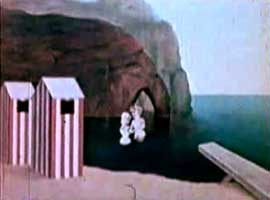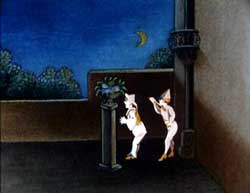 At the dawn of the history of film animation, Charles-Emile Reynaud (1844-1918) made a one & three-quarter minute hand-tinted animated cartoon, Around a Bathing Hut (Autour d'une cabine, 1895).
At the dawn of the history of film animation, Charles-Emile Reynaud (1844-1918) made a one & three-quarter minute hand-tinted animated cartoon, Around a Bathing Hut (Autour d'une cabine, 1895).
The setting is a little cove, with two bathing huts on the beach. A slim diver leaps from a board & vanishes underwater. A second diver, rather overweight, gets pushed off the board by a third figure, also vanishing underwater. The third figure follows into the drink, likewise not coming back to the surface.
A woman in long gown carrying a dog materializes on the beach, & a man steps out from one of the beach huts. Sundry minor events unfold, concluding with a little boat entering the cove.
Reynaud was the first animator ever to project an animated film. It was at his Theatre Optique in the Musee Gravin in Paris that he debuted his cartoon Poor Pierrot (Pauvre Pierrot, 1892).
Together with this film he also showed The Clown & His Dogs (Le Clown et ses chiens, 1892) & A Good Beer (Un bon bock, 1892), calling his films "Pantomimes Lumineuses," using a "praxinoscope" system (a gussied up phenakistoscope or Zoetrope) he had personally developed.
 The 500 drawings for Pauvre Pierrot were projected in segments & manipulated in various ways to create a fifteen minute show. As shown today, however, the 500 frames run less than two minutes. Le Clown et ses chiens had 300 drawings & Un bon bock had 700. The 500 drawings for Pauvre Pierrot were projected in segments & manipulated in various ways to create a fifteen minute show. As shown today, however, the 500 frames run less than two minutes. Le Clown et ses chiens had 300 drawings & Un bon bock had 700.
His only remaining film was Reve au coin du feu (1894). Due to the tremdously rapid advancements in cinema technologies, his filmmaking ended at only five films.
His praxinoscope required the animator to manipulate it personally, so the films couldn't be shown elsewhere than Reynaud's own tiny Theatre Optique, & no one but himself could manipulate the components.
But before advances left his system in the dust, & he closed his little theater in 1900, it is estimated a half-million people had seen his shows. With each showing, Renaud also provided a narration & Gaston Paulin on piano had composed original scores for each film.
In 1907 he developed a variant on the praxinoscope which permitted projection of three dimensional animation, but he never again had the enthusiasm to pursue new animated shows or compete with the many easier methods of projection that just about anyone could master. By the time he died in 1917, he was completely forgotten.
copyright © by Paghat the Ratgirl
|


 The 500 drawings for Pauvre Pierrot were projected in segments & manipulated in various ways to create a fifteen minute show. As shown today, however, the 500 frames run less than two minutes. Le Clown et ses chiens had 300 drawings & Un bon bock had 700.
The 500 drawings for Pauvre Pierrot were projected in segments & manipulated in various ways to create a fifteen minute show. As shown today, however, the 500 frames run less than two minutes. Le Clown et ses chiens had 300 drawings & Un bon bock had 700.